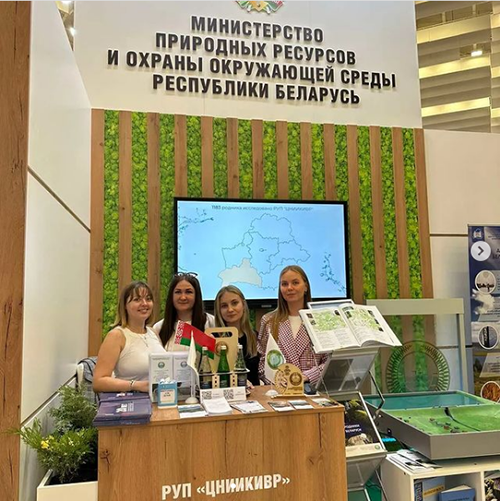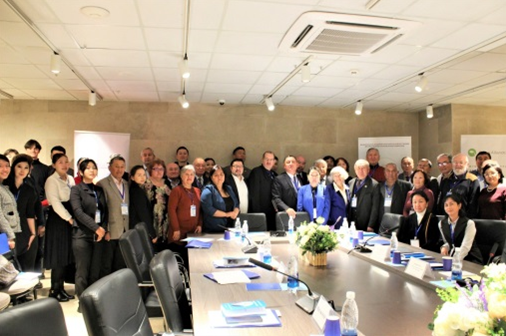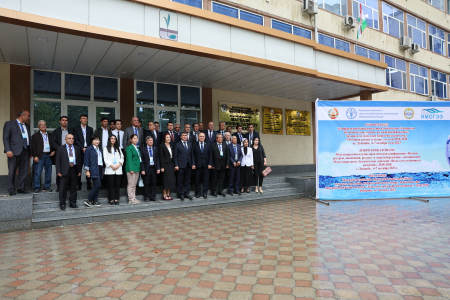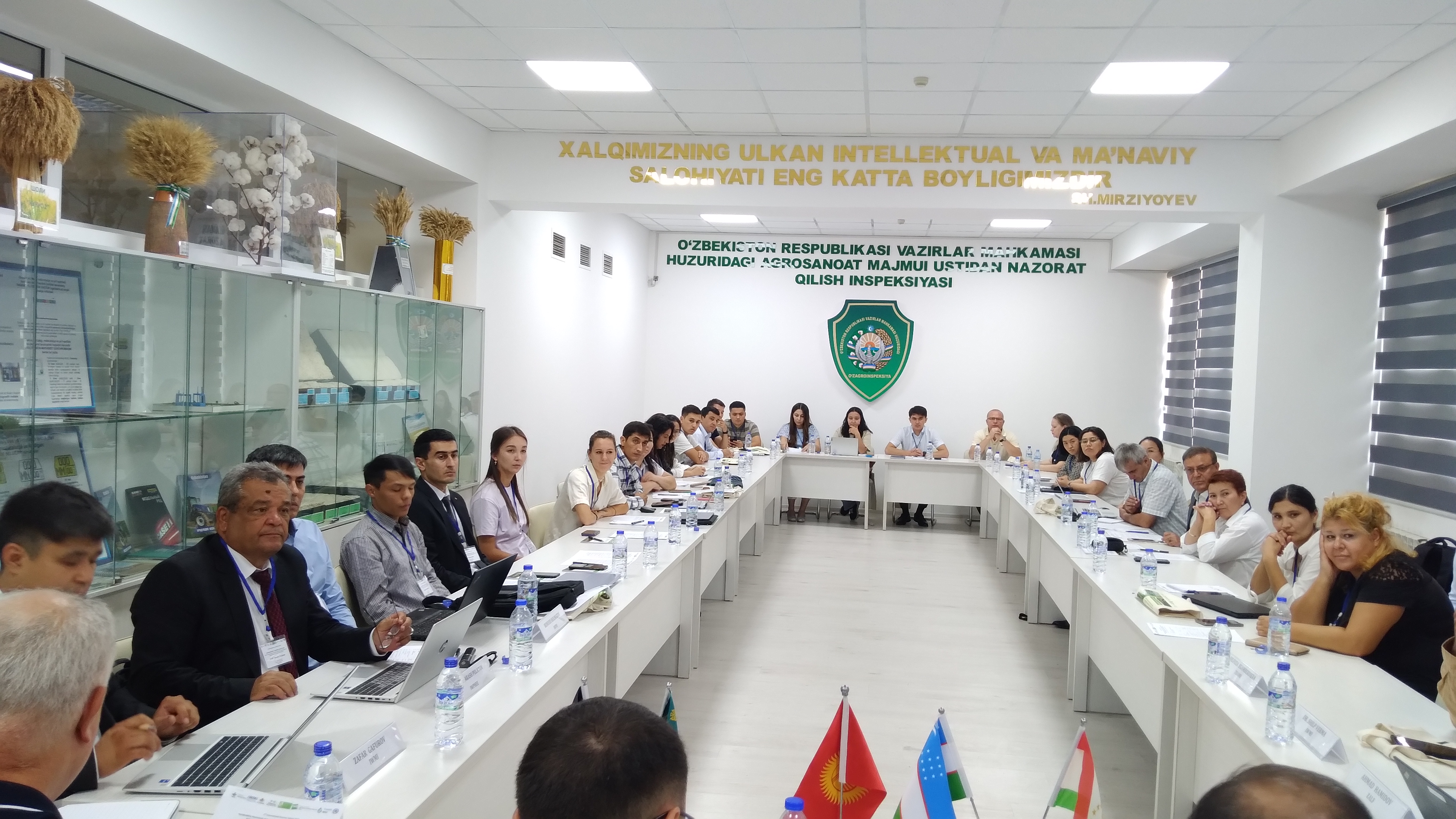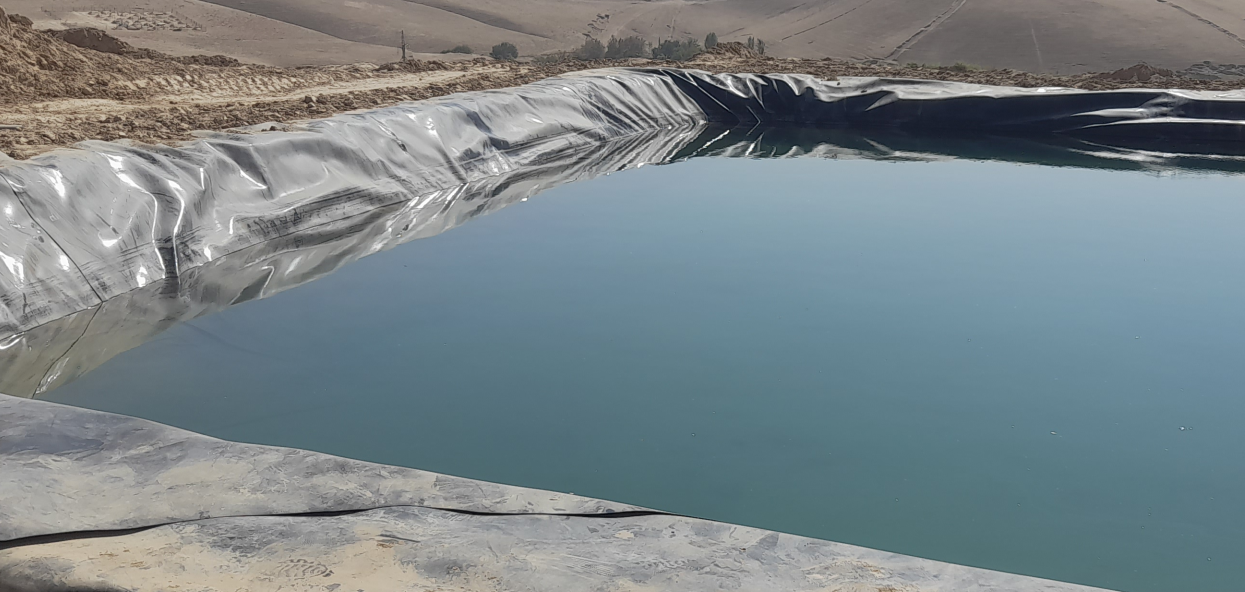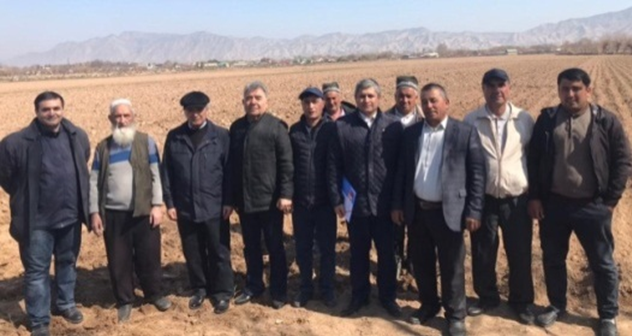
Section 10. Science and innovations
10.1. Innovations in 2023
Water Saving Technologies
The engineers at the Technology Center of the Academy of Sciences of Turkmenistan have developed an innovative injector for a drip irrigation system. This injector conserves water, fosters conditions for the growth of beneficial microorganisms that nourish plants, and recycles various industrial emissions. It is composed of lump sulfur, activated carbon, metal shavings, river sand, and soapstock or other recyclable industrial waste. The injector is a tubular device that is inserted deep into the soil, reaching the root zone. It is connected to the main water supply system, delivering water and nutrients directly to the root system. This approach prevents direct contact between water and the aerial parts of plants, thereby inhibiting decay and fungal growth.
The Kyrgyz Research Irrigation Institute has developed an ultrasonic level meter USN 5.0. This device is designed for contactless measurement of water levels in irrigation and drainage facilities. Equipped with a high-precision "Maxbotix" ultrasonic rangefinder, the meter features built-in memory and a GSM module for data transmission via MQTT (JSON) protocol. Data collection and transmission can be configured by the user to occur at frequencies of 1, 2, 4, 6, 12, or 24 times per day. The collected data is utilized to regulate flow rates in irrigation canals, thereby improving water management and promoting water conservation.
Specialists at SlySoft Community (Kyrgyzstan) have developed software that optimizes water distribution systems for agricultural fields. This system enables Water User Associations (WUAs) to calculate water use and get important recommendations for water conservation and efficient irrigation. These recommendations are based on data such as selected crops, canal type, bed form, flow capacity, and other relevant parameters.

Scientists from State University of Ponta Grossa in Brazil and the University of Louisiana in the United States have jointly investigated the impact of floating solar on the water evaporation rate in reservoirs. The researchers used the Penman-Monteith method to measure the rate of water evaporation. The 130 kW installation, occupying 1,265.14 m2 of area, reduced evaporation by 60% from the Passauna reservoir that spans 8.5 km2 and has an average depth of 6.5 meters. The results indicate that a 5 MW system could save about 16,000 m3 of water per year.
Water Treatment and Desalination
The genetic scientists from the North Carolina State University (USA) engineered genetically modified bacteria to break down plastics in saltwater. This hybrid consists of two species of microorganisms: (1) bacterium Vibrio natriegens that thrives in saltwater and reproduces very quickly; (2) bacterium Ideonella sakaiensis producing enzymes that allow it to break down PET plastics into components. This hybrid will help clean up the oceans by breaking down plastics in the water without removal.
Scientists from the Daegu Gyeongbuk Institute of Science and Technology (South Korea) developed a high-efficient water purification system that can filter out microplastics, as well as other pollutants. Covalent triazene framework (CTF), a highly porous material possessing large surface area, was used in this study. Molecules in the CTF were modified to increase hydrophilicity, and the material – exposed to mild oxidation. The filter has demonstrated the highest purification efficiency, removing more than 99.9 per cent of contaminants in 10 seconds, such as microplastics in water at ultra-high speed. The material is also capable of being reused many times without degradation of its performance.
Researchers from the University of Erlangen Nuremberg (Germany) developed nanoparticles that are intended for water purification. This "smart rust" captures various pollutants, such as oil (petroleum), nano- and microplastics and even hormones depending on the particles’ coating. The base materials used by researchers are iron oxide nanoparticles in a superparamagnetic form. They are drawn to magnets, but not to each other. To make them smart, nanometer-sized spheres are coated with phosphonic acid molecules. One end of the molecule is attached to the nanoparticles, and the other end can be tuned to be sensitive to different types of pollutants. The magnetic nature of the small rust allows particles to be removed easily from water using a magnet, taking the pollutants along with it.
Researchers at the Helmholtz-Zentrum Dresden-Rossendorf (Germany) developed the wastewater treatment technique with magnetotactic bacteria, which is used in mining (including uranium). Microorganisms accumulate dissolved heavy metals in their cell walls, and a magnetic field is used to remove them from water. Magnetotactic bacteria can survive at neutral pH values, even in aqueous solutions containing relatively high concentrations of uranium. The treatment can be carried out directly in the surface water or by pumping water from underground mines where mining is in progress and directing it to treatment plants.
Engineers from the Norwegian startup Vitaloop introduced the Defender graphene-filter water purifier. The purifier weighs 0.49 kg, measures 26.5 × 7.5 cm and is very simple in use. Just pour water of any quality into it and press a button to get about 480 ml of clean drinking water. The battery is capable of delivering up to 100 cleaning cycles per charge and the filter can withstand up to 200 cycles. The purification system consists of five parts. The first is a coarse metal mesh filter for separating coarse debris. Next is a fine (mesh) filter to capture the smallest dirt particles. The third filter retains the most part of viruses, the fourth is an activated carbon filter which purifies the water from heavy metals and toxins. The final graphene filter removes microplastic particles from water and disinfects it.
Engineers from the Massachusetts Institute of Technology (USA) and China developed a seawater desalination system, powered only by the sun. The device’s configuration allows water to circulate in artificially created eddies, similar to the natural "thermohaline" circulation of water in the ocean. This circulation, combined with the sun’s heat, causes the water to evaporate, leaving behind salt in the water. The resulting water vapor is then condensed and collected as clean drinking water. Meanwhile, the remaining salt circulates in and out of the device, rather than building up and clogging the system. The new system has a higher water output and better salt removal than all current passive solar desalination concepts currently being tested. The researchers estimate that if the system is scaled up to the size of a small suitcase, it would produce 4 to 6 liters of drinking water per hour and last for several years before needing replacement parts.
Water from Air
Engineers from the Massachusetts Institute of Technology (USA) synthesized hydrogel that can quickly extract water from dry air. The researches enhanced the hydrogel’s absorbency by adding lithium chloride - a type of salt that is known to be a powerful desiccant. The material can pull vapor from the air and hold in the moisture without leaking. The water could be heated, condensed, and then collected as ultrapure water.
Hydrogel harvesting freshwater from air was developed by the team of the University of Texas (USA). The process of extraction took 24 hours. Using their hydrogel, the researchers were able to extract almost six liters of pure water per kilo of material, from air with 30% relative humidity. The basis for the new hydrogel became a polymer constructed from zwitterionic molecules. Polyzwitterions carry both positive and negative charged functional groups, which helped the polymer to become more responsive to the salt in this case. Initially, the molecular strands in the polymer were tightly intermingled, but when the researchers added the lithium chloride salt, the strands relaxed and a porous hydrogel was formed. This hydrogel could significantly assist in water collection in arid regions.
Engineers from the New York University in Abu Dhabi (UAE) developed a simple method of harvesting water from atmosphere (fog and dew). The surface of a slowly subliming organic crystal of hexachlorobenzene allows collecting moisture droplets and guiding their motion. Transition of water from its vapour to liquid form and its movement in the desired direction were found to be caused by changes in the width of small channels that appear on the surface of the crystal. Due to sublimation (transition from the solid state to vapour), the surface of this material has a rigid topography with defined parallel channels.

Sublimation-caused widening of the channel on the crystal surface. As the channel width changes, the particles are picked up and transported by water along the channel.
Researchers from the Max Planck Institute for Polymer Research and Swiss Federal Institute of Technology (ETH Zurich) have developed a specially coated metal mesh to extract water from fog and remove environmental pollutants. A close-meshed net is made out of metal wire and coated with a mixture of polymers and titanium oxide. The polymers are selected in such a way that the water droplets are optimally deposited on the mesh and then flow as quickly as possible into a collection container so that they are not blown away by the wind. Titanium oxide acts as a chemical catalyst. It breaks down organic pollutant molecules contained in the droplets, rendering them harmless. The technology requires minimum maintenance and no electric energy as the sunlight is sufficient for its work. The titanium dioxide must receive regular irradiation with UV light to regenerate.
Innovations in Agriculture
Researchers at Russian Space Systems (Russia) have developed a complex of 'Digital Earth' geoservices powered by artificial intelligence. This platform enables users to access Earth remote sensing (ERS) data, view satellite images of the Earth's surface, filter images by region, date, and cloud cover, extract data from satellite images related to the state and development of objects and natural resources, monitor emergency situations, and conduct environmental monitoring. Additionally, the application allows users to order custom ERS products, specifying requirements such as spectral channels, bits per pixel, map projection, and other parameters.
Scientists at the Technology Center of the Academy of Sciences of Turkmenistan have developed eco-granules that accelerate the reclamation of saline soils, improve the absorption of plant fertilizers, and promote the growth of beneficial soil microorganisms. The mixture for these granules is made from calcined algae, trace elements from thermal mineral water, slaked lime, zeolite, and other additives. Importantly, this mixture is a byproduct of lake and canal cleaning processes, providing an additional source of organic matter for cultivated areas. The emulsion containing eco-granules can be directly sprayed onto plant stems.
Scientists at Belgorod State University (Russia) have developed a mobile application that can simulate optimal planting schemes for various crops in specific areas. The program can assess greenhouse gas (carbon dioxide) dynamics, crop area parameters, and help select optimal planting locations to maximize yields. The application utilizes augmented reality to visually represent the growth and development of crops in a given area and visualize the spatial and temporal distribution of greenhouse gases. To function properly, it requires a mobile phone camera and GPS.
The AI-based LaserWeeder agricultural robot, developed by engineers from the Carbon Robotics (USA), is a 6-meter-wide trailed unit with three rows of 10 lasers, towed behind the tractor. The robot is able to identify and remove weeds with millimeter accuracy without any damage to the basic crop. As it moves, the lasers precisely target the weeds and generate a concentrated beam of thermal energy to disrupt the weeds’ cellular structure that kills them. The AI-based system is able to distinguish weeds from crops, ensuring that only unwanted plants are affected. The agricultural bot is capable of operating in large-scale fields and killing over 200,000 weeds per hour, which is equivalent to the work of 70 persons.

Researchers at Cognitive Pilot Company (Russia) have designed an agricultural robot, the Cognitive Soil Analyzer, to analyze soil composition and condition. The robot measures the degree of absorption and reflection of electromagnetic quanta across various spectral bands to determine mineral content, and utilizes electromagnetic induction to assess soil acidity and electrochemical potential. The analysis can be conducted up to one meter deep. Additionally, the robot can measure soil compaction by determining its mechanical resistance to applied force. Soil measurements are automated and conducted in real-time as the robot traverses a predefined route at a specified frequency. To achieve accurate measurements, a grid of points is established, with distances between points ranging from 25 to 100 meters or other user-defined resolutions. Measurements are stored as sets of geo-referenced soil parameters. As a result, the Cognitive Soil Analyzer contributes to optimized field map illustrating the distribution of soil indicators.
An unmanned 20-storey vertical "plants factory", launched in Chengdu (China), was developed by specialists at the Institute of Urban Agriculture under the Chinese Academy of Agricultural Sciences. It is a multi-layered system that enables continuous and highly-efficient green food production through innovative technologies, starting from simulation of natural conditions and ending with energy-saving artificial lighting. The produce (leafy greens, fruits and mushrooms) do not differ, in terms of vitamin and microelement content, from those grown in a "traditional" greenhouse. This system can be utilized for food production in urban areas as well as in deserts and on barren land.

Alternative Energy
Japanese battery startup company PowerX unveiled its inaugural ship - a tanker designed to transport electric energy by sea. The company aims to complete its first tanker by 2025. The electric tanker equipped with 96 containerized marine-grade batteries, providing a total capacity of 241 MWр, will be 140 m long. PowerX will utilise its own proprietary battery system based on lithium-iron-phosphate battery cells that can manage a lifespan of over 6,000 charge cycles. The tanker with an electric cruising range of up to 300 km is designed to transport electric energy by sea to the above distance.

Researchers at the Royal Melbourne Institute of Technology (Australia) have developed a proton battery with such an energy-per-unit mass which is comparable with the best commercially-available lithium-ion batteries. Batteries are based on chemical reactions with proton exchange, provide safety in operation and enable their complete recycling. The main resource used in a new battery is carbon, which is much more available and cheaper than other resources such as lithium, cobalt and vanadium.
Researchers at the Massachusetts Institute of Technology (USA) have developed a technology of concrete batteries that are both building material and an energy-storing unit. This technology allows turning the entire building into a giant battery without change in its service, manufacturing thousands of kilometers of concrete roads that will also serve as an energy-storage system. When mixing concrete, a mortar of cement powder, water and carbon black is used. The liquid naturally forms a branching network of openings that penetrate the whole concrete, and the carbon migrates into these spaces, thus turning concrete into a giant conductor or electrode. Capacitors are formed of a set of two conductive plates of modified concrete which are separated by an insulator and a suitable electrolyte. Relying on calculations, a concrete block of 45 m3 in size would have enough capacity to store about 10 kWh of energy.
Specialists of the Ambri startup (USA) have developed a liquid-metal battery composed of liquid-metal electrodes and molten-salt electrolyte. A battery consists of three liquid layers arranged by density. The bottom layer with the highest density is a cathode made of molten antimony. The top layer with the lowest density is an anode made of calcium alloy. And electrolyte made of molten calcium chloride is the middle layer between the top and bottom ones. The battery needs no membranes or separators between these layers. The liquid-metal battery is not flammable, unlike lithium-ion battery, and resistant to capacity fade. The tests demonstrate that the battery retains 95% of its capacity even after the long-term operation.
10.2. Leading Research Institutes of EECCA Countries
Belarus. Republican Unitary Enterprise "Central Research Institute for Complex Use of Water Resources" (RUE "CRICUWR")
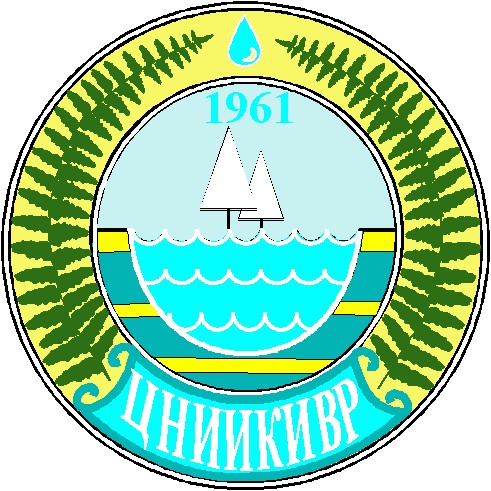 RUE "CRICUWR" is the sole specialized state research institution in Belarus dedicated to fundamental and applied research in sustainable water use and protection. The institute is responsible for providing scientific support to the sectoral policies developed by the Ministry of Natural Resources and Environmental Protection of Belarus in the realm of water use and protection. As an accredited scientific organization and holder of an environmental compliance certificate , the institute conducts research and development in natural and engineering sciences. Additionally, it offers training programs in Geoecology (25.03.13) and Land Hydrology, Water Resources, and Hydrochemistry (25.03.05).
RUE "CRICUWR" is the sole specialized state research institution in Belarus dedicated to fundamental and applied research in sustainable water use and protection. The institute is responsible for providing scientific support to the sectoral policies developed by the Ministry of Natural Resources and Environmental Protection of Belarus in the realm of water use and protection. As an accredited scientific organization and holder of an environmental compliance certificate , the institute conducts research and development in natural and engineering sciences. Additionally, it offers training programs in Geoecology (25.03.13) and Land Hydrology, Water Resources, and Hydrochemistry (25.03.05).
RUE "CRICUWR" focuses its research and development efforts on: (1) addressing socio-economic and environmental policy objectives in Belarus, and (2) the areas aligned with strategic goals and targets set under the SDGs , National Strategy for Sustainable Social and Economic Development of the Republic of Belarus for the period up to 2030 and the Concept of the National Strategy for Sustainable Development of the Republic of Belarus for the period up to 2035 , Strategy in the field of environmental protection for the period until 2025 and in the Strategy for scientific, technical and innovative development in the field of environmental protection and sustainable use of natural resources for the period up to 2025 .
The Institute's primary areas of focus include: (1) development of river basin management plans and water balance assessments; (2) environmental impact assessments for engineering activities within river basins; (3) assessment and forecast of changes in water resource conditions under both natural and human-induced factors; (4) evaluation of the recreational potential and capacity of water bodies; (5) development of environmental protection measures to safeguard and restore surface and groundwater bodies; (6) development and updating of schemes and projects for water protection zones, coastal strips, and sanitary protection zones for water intakes; (7) comprehensive assessments of the ecological state of river basins experiencing significant human impact; (8) maintenance of the State Water Cadastre (SWC) of the Republic of Belarus; (9) provision of postgraduate education and training in relevant fields; (10) engagement in international scientific-technical cooperation.
Activities in 2023
RUE "CRICUWR" provides information services to various economic sectors, offering data on water bodies, water resources, hydrological regimes, water quality, water usage, and wastewater discharge. Additionally, the organization prepares information materials for international organizations such as the UN and UNESCO, focusing on water resources and their utilization. To support these services, RUE "CRICUWR" develops and maintains the following information systems and resources: (1) SWC Interdepartmental Database, which consolidates summary data on water resources and their use; (2) Information Database for SWC Sections. This web-based application provides online access to summary data in Excel table format and dynamic graphs of indicators. Data is categorized by administrative-territorial entities (regions, districts, cities of regional subordination, and Minsk city), river basins, and economic activity types; (3) aautomated information system "State Statistical Reporting on Water Use" (1-water).
Events. RUE "CRICUWR" hosted the following: (1) II international scientific-practical conference "Topical issues of efficient and integrated water use", which adopted resolution (Minsk, March 22-24); (2) workshop "Youth Policy in RUE "CRICUWR"" (Minsk, October 30); (3) roundtable "Specifics of regulation and control of wastewater and stormwater sewerage system in settlements" (Minsk, November 29).
Representatives of the Institute took part in: (1) exhibition of scientific and technical achievements "Intellectual Belarus" (Minsk; January 21-22); (2) workshops "Sound use of water resources" (Vitebsk, March 3; Brest, March 31), "Treatment facilities. Examples of implementation. Audit of existing treatment facilities" (Minsk, April 18) and "Sound use of water resources" (Gomel, September 8); (3) roundtable "Uniting the efforts of the public and private sector to guarantee environmental wellbeing" (St. Petersburg, Russian Federation, May 26); (4) II international specialized exhibition "ECOLOGY EXPO - 2023" and XVII Republican Ecological Forum (Minsk, August 22-24); (5) Festival of Science (Minsk, September 2); (6) practical workshop of experts of the joint Belarusian-Russian Commission on the protection and sustainable use of transboundary water bodies and laboratory services of the Russian Federation and the Republic of Belarus (Pskov, Russian Federation, September 20); (7) XX international scientific conference of young scientists "Youth in Science – 2023" (Minsk, September 20-22); (8) Republican Competition of Innovation Projects 2023 (Minsk, December 6).
Cooperation. The Institute signed: a program of scientific, technical and innovative cooperation with the FSBEI "Russian State Hydrometeorological University" for the period up to 2025 (St. Petersburg, Russian Federation, May 26); an agreement with the Belarusian Agricultural Academy (BSAA) on the organization of a branch of the Department of Hydraulic Structures and Water Supply in the Institute (Gorki, Mogilev region, July 7).
Publications. Articles of the Institute’s members were published in (1) journals Natural resources, No.1-2; Ecology No.1, 3; Melioration No.4; Industrial ecology No.1, 12; Water sector of Russia: problems, technologies, management No.6; collection of scientific papers Urgent problems of ecology; (2) proceedings of conferences "Topical issues of efficient and integrated water resources use" (March 21 – 22); Innovation technologies in water, utilities sectors and water transport (April 27-28); Sakharov readings 2023: environmental problems of the XXI century (May 18-19); Youth in science – 2023 (September 20-22); Minsk Scientific Readings - 2023 in 3 volumes (December 6-8).
Source: RUE "CRICUWR"
Kazakhstan. "Kazakh Scientific Research Institute of Water Economy" TOO (KazSRIWE)
The KazSRIWE TOO established in 1950 in Taraz is the leading research organization in the area of water management, land reclamation and irrigation, watering technology and technique, agricultural water supply and pasture watering, and water economics. The Institute’s mission is to deliver research, design and educational activity to ensure effective and sustainable development of the water sector in the context of integrated water use and water security of the country.
Activities in 2023
Research. Research efforts of the Institute are focused on irrigation technologies and technique for new irrigated land and reconstruction and modernization of existing irrigation systems.
The Institute has been implementing the following items from the Concept of Water Management System Development in the Republic of Kazakhstan for 2024-2029: Development of a handbook on water-saving irrigation technologies; Development of a mechanism for setting regional water use limits for provinces, cities, capital, districts and primary water users, based on short-term forecasts of water availability, environmental and sanitary-epidemiological status of water bodies, and the level of stress on water resources; Studies to modernize the design parameters and operating regimes of large reservoirs on transboundary rivers (Kapchagai, Bukhtarma, Shardara) in light of changing transboundary inflows; Assessment and forecasting of water balance of the transboundary Syr Darya River. This is part of preparations for joint research with Central Asian countries aimed at improving and justifying the allocation of water resources between countries.
Capacity building. KazSRIWE jointly with the POMU (Production and Operational Management Unit) of the Zhambul branch of the RSE "Kazvodhoz" held a training workshop for water employees on operational hydrometry, water accounting, operation of collector-drainage network and vertical drainage wells (Taraz, March 13-17).
Events. KazSRIWE held a technical meeting on automation of water management, in which representatives of such companies as Rubicon (Australia), GWF (Germany), GST EURASIA, and HST Systemtechnik took part. The Institute was assigned the role of a single operator of digitalization in the national water sector.
Representatives of the Institute took part in: (1) the regional workshop on monitoring, assessment and information exchange in Central Asia (Astana, February 1-2); (2) roundtable "Young water professionals" (Taraz, March 15); (3) working meeting held at the JSC "Institute of Geography and Water Security" under the Ministry of Science and Higher Education of the Republic of Kazakhstan (Almaty, December 23).
Media. The interviews were given: to the Kazakhstan’s agrarian online site ElDala.kz on how to save 30% of irrigation water (April 6) and to the TV channel 24kz on how to combat water scarcity" (October 2).
Source: KazSRIWE
Kyrgyzstan. Kyrgyz Irrigation Research Institute (KIRI) at the Ministry of Agriculture, Water Resources and Processing Industry of the Kyrgyz Republic
KIRI was established in 1953 as the Institute of Water Management and Energy. In 1973, the Institute was granted the status of All-Union Research Institute for Integrated Automation of Irrigation and Drainage Systems. The Institute was renamed KIRI in 1992. In 2022, it was transferred to the Ministry of Agriculture . It currently operates as a subordinate organization with its own charter.
KIRI comprises six scientific laboratories focused on meliorative hydrogeology and water management challenges, irrigation and soil erosion research, crop irrigation regimes and agromelioration, surface water monitoring, hardware and software for automation of water metering and water distribution, geoinformation systems and databases. Additionally, KIRI includes a Center for the Development of Digitalization and Water Management Systems. The Institute employs 68 staff members, including 6 Doctors of Science, 6 Candidates of Science, and 29 researchers.
KIRI's primary areas of focus include: (1) research and development, design and commissioning in the fields of water management, agriculture, ecology, and information technology; (2) development and promotion of advanced techniques, new technologies, and devices in irrigation and drainage facilities; (3) integrated water resource management; (4) digitalization of agricultural sector, provision of services to design and industrial companies, as well as peasant farms and agricultural enterprises; (5) crop growth and development; (6) development of normative and technical documentation for the water industry; (7) automation system development and maintenance; (8) education, training an consultation on information technology and sustainable natural resource use.
Activities in 2023
Research. The research efforts have focused on the following areas: (1) development of rational schemes for groundwater use and management in the western part of the Chuy Valley to ensure sustainable irrigation and desalinization in the context of water scarcity; (2) selection of irrigation technologies and technique for growing crops on sloping land of Chuy province with the use of GIS technologies; (3) study of the impact of actual irrigation regimes on crop yields in the Chuy and Naryn intermountain basins, development of recommendations on their correction; (4) development of recommendations for agricultural production on irrigated land in light of current and forecast changes in river runoff under conditions of global climate change; (5) integration of automated water metering, water distribution and irrigation control systems to improve irrigation water use efficiency in the Chuy Valley; (6) development of reference-analytical database of indicators on irrigated land conditions in the Chuy province with the use of GIS technologies..
The Institute has got 8 certificates of practical application of its research: 1 certificate for implementation of the "Procedure for calculation of horizontal, vertical and combined drainage systems in Bishkek city"; 7 certificates on putting into operation of the computer program for calculation of CDW (collector-drainage water) flow and compilation of the final inventory of observation wells, as well as transfer of 27 paper maps and their electronic versions to computers of Sokuluk, Moscow, Zhayyl and Alamedin land reclamation field offices (Chuy province).
Contract-based activities on development and implementation of automated irrigation water delivery and distribution accounting system are in progress in the Chuy district water management organization. Similar activities have been started in other districts of Chuy province.
Events. KIRI specialists presented their research findings at 17 international and national scientific-practical conferences, workshops, roundtables, and coordination meetings.ах.
Publications. KIRI staff members have published: chapter "Creation of Rational Groundwater Management Schemes in the Chuy Valley, Kyrgyz Republic based on Groundwater Modeling" in the monograph "Groundwater in Arid and Semi-Arid Areas. Monitoring, Assessment, Modelling and Management", Springer, 2023; articles in the journal News of Higher Educational Institutions of Kyrgyzstan, No. 6, 2022 – "Soil protection in Kyrgyzstan", "Agrophysical and chemical soil properties in the Chuy valley and their change during prolonged irrigation", "Fertilizers - the basis of soil fertility and crop yields".
Source: KIRI
Kyrgyzstan. Institute of Water Problems and Hydropower of the National Academy of Sciences of the Kyrgyz Republic (IVP&GE of NAN KR)
 The IVP&GE of NAN KR was established in 1992. The Institute’s activity is focused on fundamental research and applied technology development in the area of hydrology and hydropower. The Tien Shan Highland Research Center (TShHRC) and the Ala-Archa Polygon for studies of hazardous hydrological processes, and also 6 laboratories operate at the Institute.
The IVP&GE of NAN KR was established in 1992. The Institute’s activity is focused on fundamental research and applied technology development in the area of hydrology and hydropower. The Tien Shan Highland Research Center (TShHRC) and the Ala-Archa Polygon for studies of hazardous hydrological processes, and also 6 laboratories operate at the Institute.
Activities in 2023
Research. The Institute has been implementing the program "Analysis of opportunities for forecasting and management of water and energy resources in the Kyrgyz Republic in the context of climate change and under anthropogenic load" for 2021-2023. The key areas of this research include: (1) monitoring of the potential for catastrophic outburst floods from high-mountain lakes; (2) studying regional patterns of formation, regime, distribution, interrelationships, protection, assessment, and interaction of surface and groundwater resources; (3) development and justification of groundwater management schemes in the eastern part of the Chuy Valley based on non-stationary geofiltration models; (4) studying hazardous exogenic hydrogeological processes in the Tien Shan; (5) creation of remote sensing-based geoinformation system for monitoring water and land resources in Kyrgyzstan.
Researchers continuously monitor the status of potential outburst lakes in the Ala-Archa River valley through regular stationary measurements of key hydrometeorological parameters.
The Institute continues its participation in the UNESCO project "Strengthening the resilience of Central Asian countries by enabling regional cooperation to assess high-altitude glacio-nival systems to develop integrated methods for sustainable development and adaptation to climate change." The project's goals, methodologies, and anticipated outcomes were presented at the project's inception workshop (Paris, France, July 6-8).
The Institute collaborates with the Federal Center for Integrated Arctic Research of the Ural Branch of the Russian Academy of Sciences (FECIAR UrB RAS) on glacier research. As part of a youth grant from the Russian Science Foundation, a joint expedition near the Ala-Archa River collected samples of water, ice, and precipitation. They also performed field measurements of water properties (temperature, conductivity, pH, etc.). Laboratory analysis will reveal glacier melt rates and their impact on river basin water balance and degradation of buried ice and permafrost, and their contribution to river runoff.а.
Capacity building. The following events were held at the TShHRC : (1) 3rd summer school-2023 "Knowledge Transfer and Data Exchange" under the program "Integrated Glacier Monitoring" , during which the participants got acquainted with the work of TShHRC field stations, such as the lake zone at Kara-Bulun, the forest zone at the Chon-Kyzyl-Suu hydrometeorological station and the nival-glacial zone of the Kara-Batkak glacier (Kyzyl-Suu village, August 8-15); (2) safety procedure training on the Kara-Batkak glacier (Teskei Ala-Too ridge) - the most difficult one for glaciological monitoring (August 31 - September 5).
An open lecture "School of Scientific Interests" was held for students of the Kyrgyz National University named after J.Balasagyn in such areas as "Geography", "Ecology and Nature Management" (Bishkek, February 28,).
Staff members of the Institute took part in the expedition aimed to assess the ecological status of the Amu Darya river basin, during which they visited the BWO "Amu Darya", head HPP in Levakand, Danghara irrigation tunnel, Rogun and Nurek HPP (Tashkent-Muynak-Nukus-Urgench-Bukhara-Alat-Farab-Termez-Bokhtar-Levakand, April 23 - May 5).
Events. The IVP&GE organized: (1) round table "The reason for water scarcity in the Bishkek city and in Kyrgyzstan as a whole" (June 15); (2) international scientific-practical conference "Problems of monitoring, modeling and forecasting of water and energy resources of Central Asia in the context of climate change" (III Mamatkanov Readings) (9 November).
Representatives of IVP&GE of NAN KR took part in: (1) international conference "Environmental and socio-economic security as a factor of sustainable mountain development" dedicated to the results of the "2022 International Year of Sustainable Mountain Development" and the roundtable "The role of documents adopted at the concluding event of the International Year of Mountains - Bishkek Global Mountain Summit (2002) for the sustainable development of mountain regions in the period from 2002 to 2022" (Bishkek, January 19-21); (2) roundtable "UNESCO Global Geoparks: Opportunities and Potential in the Kyrgyz Republic" (Bishkek, February 9); (3) conference "Water Resources in Central Asia: Challenges and Prospects" (Bishkek, March 18); (4) the meeting "Water Resources in Central Asia: challenges and prospects"17 (March 31); (5) "Bishkek Water Forum – 2023" (May 31); (6) the Issyk-Kul Forum "Actual issues of environmental research for sustainable development in arid zones" (Chok-Tal village, Issyk-Kul, August 16-17); (7) International Forum on Sustainable Development of Ecology and Environment in the Silk Road Economic Belt (Urumqi, China, September 17-19); (8) 10th Euro-Asia Economic Forum (Xi'an, China, September 22); (9) Regional Meeting on Robust Decision Support (RDS) Process for the Amu Darya River Basin, the 5th meeting of the Regional Coordination Committee, and the celebration of the Amu Darya River Day at the regional level (Khiva, Uzbekistan, September 25-27); (10) All-Russian Conference "II Laverov Readings – The Arctic: Current Problems and Challenges" (Arkhangelsk, RF, November 13-17); (11) Central Asian forum "Women in Science and Education" (Bishkek, November 16); (12) international scientific-practical conference "Mudflow Safety - 50 years of Kazselezaschita’s activities: Status and Prospects" (Almaty, Kazakhstan, November 22-24); (13) III Congress of Young Scientists (Sochi, RF, November 28-30); (14) international roundtable "Application of Digital Technologies in Science" (December 11, Bishkek); (15) 2nd meeting of the regional working group to discuss a mutually beneficial mechanism for water and energy cooperation (Almaty, Kazakhstan, December 15).
Cooperation. The IVP&GE of NAN KR signed a memorandum of cooperation with the Xinjiang Institute of Ecology and Geography (XIE&G) of the Chinese Academy of Sciences (March 1).
The Institute held meetings with: (1) a delegation of the Xinjiang Branch of the Chinese Academy of Sciences (February 15), (2) a WB water expert (February 15), (3) EU representatives (April 26).
Media. Interviews were given to: (1) Kyrgyz Radio "1" on "Today is a World Water Day" (March 22) and "Kyrgyz Mountains as a Source of Water" (November 27); (2) the online journal "Vostochny Express 24" on "How Kyrgyzstan conquers the Russian Arctic..." describing collaboration between the IVP&GE of NAN KR and the Federal Center for Integrated Arctic Research of the Russian Academy of Sciences (June 22); (3) the State television and radio broadcasting company "ElTR" (November 30).
Source: IVP&GE of NAN KR
Russia. Federal State Budgetary Institution "Russian Research Institute for Integrated Water Management and Protection (FSBI "RosNIIVKh")
 FSBI "RosNIIVKh" was founded in 1969. It consists of the lead institute in Rostov-on-Don and branches in Yekaterinburg, Vladivostok, Chita, Perm and Ufa. Since 2009, the Water Museum has been functioning at the Institute. The Water Sector Professional Development Center (WSPDC) started to function since 2020. FSBI "RosNIIVKh" is a member of the of EECCA Network of Water Management Organizations.
FSBI "RosNIIVKh" was founded in 1969. It consists of the lead institute in Rostov-on-Don and branches in Yekaterinburg, Vladivostok, Chita, Perm and Ufa. Since 2009, the Water Museum has been functioning at the Institute. The Water Sector Professional Development Center (WSPDC) started to function since 2020. FSBI "RosNIIVKh" is a member of the of EECCA Network of Water Management Organizations.
The main areas of activity include: (1) scientific, methodological, and information support for the study, use, and protection of water resources; (2) development and support of information systems for government authorities at all levels, including informative, advisory, diagnostic, expert, research, design, and control systems; (3) development of pre-design materials for the use and protection of water bodies, as well as for the prevention and mitigation of floods and other water-related hazards, and ensuring the safety of hydraulic structures; (4) development and implementation of high-tech, science-intensive management tools for water resource use and protection; (5) monitoring of water quantity and quality and conducting laboratory analyses of water and sediment quality; (6) technical regulation, standardization, and water certification.
Activities in 2023
Events in which the FSBI "RosNIIVKh" took part include: (1) environmental marathon "River Defender’s Day" and roundtable "How to save our rivers: federal and regional projects and initiatives" (Vladivostok, March 1); (2) educational campaign dedicated to the World Water Day and exhibition "At the Frontiers of Water Sector Development" (Water Museum of the Ural Branch, March 16); (3) II international specialized exhibition "ECOLOGY EXPO-2023" (Minsk, August 22); (4) All-Russian scientific-practical conference "Water resources in the face of global challenges: ecological problems, management, monitoring" (Rostov-on-Don, September 20-23); (5) XIV meeting of the joint Belarusian-Russian Commission on the protection and sustainable use of transboundary water bodies (Minsk, August 23); (6) III Russian Environmental Forum focused on environmental monitoring, state support and building of new infrastructure for solid municipal waste management, green investments and sustainable financing, formation of a closed-loop economy in Russia (Moscow, October 9 - 11); (7) bilateral working meeting of experts from Russia and Kazakhstan during which the implementation of the Unified Roadmap for enhanced scientific cooperation in large river basins, such as Ural (Zhaiyk), Irtysh (Ertis) and others was discussed (Ekaterinburg, October 20).
Publications. In 2023, the Institute published 6 issues of the journal "Water sector of Russia: problems, technologies, management", in which, among others, the articles of the Institute staff members were included. The Institute also publishes twice a month a water sector digest
Source: FSBI "RosNIIVKh"
Tajikistan. Institute of Water Problems, Hydropower and Ecology of the National Academy of Sciences of Tajikistan (IWPH&E of NAST)
 IWPH&E of NAST was founded in 2002 . It carries out diverse research, including comparative analysis of energy efficiency of large rivers in Tajikistan, development of a unified economic criterion of hydropower development; development of methods for regulation and forecasting of flow for hydropower and irrigation purposes, assessment of economic value of water under joint use for hydropower and irrigation; optimization of hydropower operation and planning of hydraulic facilities in river basins of Tajikistan; studies of climate impact on water and energy resources and development of methods for hydropower adaptation; analysis of international and national legislation on transboundary water and energy sharing, causes of hydropower and irrigation conflicts between the Aral Sea Basin countries and development of proposals for their solution.
IWPH&E of NAST was founded in 2002 . It carries out diverse research, including comparative analysis of energy efficiency of large rivers in Tajikistan, development of a unified economic criterion of hydropower development; development of methods for regulation and forecasting of flow for hydropower and irrigation purposes, assessment of economic value of water under joint use for hydropower and irrigation; optimization of hydropower operation and planning of hydraulic facilities in river basins of Tajikistan; studies of climate impact on water and energy resources and development of methods for hydropower adaptation; analysis of international and national legislation on transboundary water and energy sharing, causes of hydropower and irrigation conflicts between the Aral Sea Basin countries and development of proposals for their solution.
The Institute offers: (1) master’s programs in such disciplines as "Hydraulic engineering", "Ecology", "Natural water and wastewater treatment", "Environmental monitoring", "Rational use and protection of water resources", "Energy efficient technologies and energy management" since 2014; (2) PhD programs in such disciplines as "Ecology", "Hydrology", "Meteorology", "Hydraulic engineering and facilities", "Water resources and water use", "Construction" since 2017.
Activities in 2023
Research. Research efforts were continued on: (1) "Problems of formation and regulation of solid runoff in waters of Tajikistan and their solution" (2020-2024); (2) "Development strategy and optimization of energy balance. Hydro-coal scenario of energy sector development in Tajikistan" (2020-2024).
Events. The Institute held the international scientific-practical conference "Water Resources, Innovation, Resource and Energy Conservation" on October 6 -7 in Dushanbe.
Representatives of the Institute took part in: (1) conference "Transformative Future for Water Security"/TFWS (Cape Town, South Africa, February 15-17); (2) scientific-theoretical conference "Global Initiatives of Tajikistan on Water Issues" (Dushanbe, February 20); (3) workshop "Science for Diplomacy" (OSCE Office, Dushanbe, March 20-24); (4) 2nd International Summer School "Assessing the sustainability of water-energy-food-ecosystem nexus for irrigated agriculture: interdisciplinary approaches for Central Asia (WEFCA)" (Tashkent, August 21-25); (5) national training on integrated water-energy modelling using the WEAP and LEAP software (Dushanbe, November 15-16); (6) international scientific-practical conference "Mudflow Safety - 50 years of Kazselezaschita’s activities: State and Prospects" (Almaty, Kazakhstan, November 22-24).
Cooperation. The IWPH&E hosted a meeting with the delegation of the Xinjiang Institute of Ecology and Geography at the Chinese Academy of Sciences and signed a Memorandum of Cooperation (Dushanbe, March 9).
In 2023 the IWPH&E signed the agreements and memoranda of cooperation also with the River Ecosystems Laboratory of the Environmental Institute at the Ecole Polytechnique Federale de Lausanne/Research Group on Environment & Climate of the Department of Geography at the University of Zurich (March 27), China University of Geosciences (Wuhan)/Xinjaing Institute of Water Resources and Hydropower Research (May 22), Northwest Institute of Eco-Environment and Resources of the Chinese Academy of Sciences (June 20), Navoi branch of the Academy of Sciences of the Republic of Uzbekistan (September 15), College of Water Conservancy & Agricultural Engineering of the Shihezi University (October), Institute of Geography and Water Security of the Science Committee at the Ministry of Science and Higher Education of the Republic of Kazakhstan (November), Iran Water Research Institute (December 28).
Media. Prof. Ya.E. Pulatov gave an interview to the correspondent of the NIAT (National Information Agency of Tajikistan) "Khovar" on the importance of the UN Water Conference held on March 22-24 in New York.
Publications. In 2023, the Institute published 4 issues of its journal "Water Resources, Power Engineering and Ecology".
Other publications included: monograph by M.S. Safarov, A.R. Fazylov "Remote sensing and monitoring of mudflow-prone mountainous territories of Tajikistan" - Dushanbe: "Promexpo", 2023. - 192 p.; Proceedings of the international scientific-practical conference "Water resources, innovation, resource and energy saving" – Dushanbe, October 6-7, 2023. – 288 p.
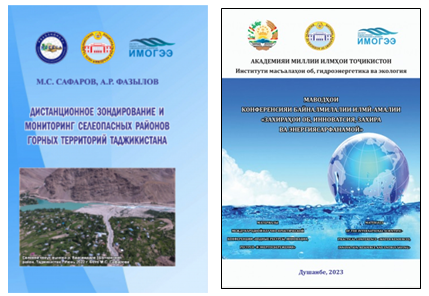
In partnership with the State Enterprise "Research Institute of water engineering and amelioration" (TajikNIIGiM), a book by Ya.E. Pulatov and Kh.U. Yuldashev titled "Water resources, hydrochemical characteristics and reclamation of saline land in the Syr Darya River Basin" was published.
Awards.The Institute staff members - A.R. Fazylov and J.B. Niyazov - were awarded the jubilee medal "50 years of Kazselezaschita" (for work in the area of mudflow control).
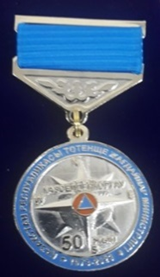
On occasion of the 32nd anniversary of Independence of the Republic of Tajikistan, Dr. Gulakhmadzoda Aminjon Abdudzhabbor, director of the scientific-educational and analytical division of IWPH&E was granted the Ismaili Somoni Award for young scientists for his outstanding work in science and technology (August 30).

Source: IWPH&E of NAST
Tajikistan. State Enterprise "Tajik Research Institute of Water Engineering and Amelioration" (SE "TajikNIIGiM")
 SE "TajikNIIGiM" was founded in 1978 as a branch of the A.N. Kostyakov All-Union Research Institute of Irrigation and Water Management (VNIIGIM). In 1994, it transformed into the Scientific and Production Association (SPA) "TajikNIIGiM." Subsequently, in 2009, it was granted the status of a State Enterprise. The Institute encompasses four key research centers: Gissar Research Center; Scientific-Research Center of J. Balkhi district; Sughd Scientific-Research Center; and, Bokhtar Scientific-Engineering Center. The primary focus of the Institute and its affiliated organizations is conducting research and demonstration projects in the field of crop irrigation techniques and technologies.
SE "TajikNIIGiM" was founded in 1978 as a branch of the A.N. Kostyakov All-Union Research Institute of Irrigation and Water Management (VNIIGIM). In 1994, it transformed into the Scientific and Production Association (SPA) "TajikNIIGiM." Subsequently, in 2009, it was granted the status of a State Enterprise. The Institute encompasses four key research centers: Gissar Research Center; Scientific-Research Center of J. Balkhi district; Sughd Scientific-Research Center; and, Bokhtar Scientific-Engineering Center. The primary focus of the Institute and its affiliated organizations is conducting research and demonstration projects in the field of crop irrigation techniques and technologies.
Activities in 2023
Practical application of research. The Institute's scientists have collaborated closely with farmers in the districts of Danghara, Bobojon Gafurov, Mastchoh, Jayhun, Jaloliddin Balkhi, and Gissar to implement scientific advancements. Notable achievements include: construction of geomembrane reservoirs of 5,000 cubic meters; intensive gardening; slope gardening on an area of 2 hectares, equipped with a drip irrigation system.
The Institute also plans to conduct in-depth research on crop irrigation scheduline in the context of climate change in Tajikistan..
Capacity building. The Institute has organized the following events: (1) field day titled "Ways to Prevent Soil Degradation and Increase Productivity Using Innovative Methods: A Case Study of Shahritus District" for representatives of district irrigation and land reclamation organizations and farmers (March 1); (2) lecture on the challenges of agricultural machinery and technological equipment use in Tajikistan delivered to graduates of the Faculty of Agricultural Mechanization at the Sh. Shotemur Tajik Agrarian University (April 8); (3) roundtable discussion on "Conventional and Modern Methods for Determining Flow Velocity and Rate and Their Significance in Water Resource Development" for representatives of the local irrigation and land reclamation organization, Amu Darya and Vakhsh Basin Authorities, WUAs and farmers (June 22); (4) training sessions on digital protection and information security in the water sector (March) and international and national water law (November 24).
By the decision of the Higher Attestation Commission of the Russian Federation, B.S. Sanginova, head of the Irrigation Technique and Technology Department, was awarded the degree of Candidate of Agricultural Sciences in Farming and Crop Production.
Events. A Republican scientific-practical conference titled "Financial and Economic Mechanisms for Improving Water Resources Management for Sustainable Development of Tajikistan" was held on December 15th in Dushanbe.
Cooperation. The Institute maintains ongoing collaborations with various organizations, including: Institute of Water Problems, Hydropower, and Ecology of the National Academy of Sciences of Tajikistan (IWPH&E); Institute of Soil Science and Agrochemistry of the Academy of Agricultural Sciences of Turkmenistan; Tajik Agrarian University named after Sh. Shotemur; All-Russian Hydraulic Engineering and Land Reclamation Research Institute (VNIIGIM); GWP; GWP, SIC ICWC, FAO, UNDP, NRU "TIIAME" and KIRI.
Publications. The Institute’s publications in 2023 incluided: Handbook for Determination of Flow Velocity and Rate in WUAs by the Traditional Method and with the Use of Digital Technologies; Textbook "Land Use and Its Improvement"; Recommendations on use of saline irrigated land in the South-Eastern Zone of Tajikistan; Recommendations on innovative technologies of crop irrigation in the context of climate change in Tajikistan; Guidelines on development of integrated measures for more efficient water and energy use for designed new and modernized old pumping irrigation systems in Tajikistan; Volume VI of the Collection of scientific papers titled "Water Management: Problems and Ways of Sustainable Development".
Kh. Sharofiddinov's article titled "How do the number of water users and a land reform impact on agricultural water availability?" was published in ELSEVIER-Agricultural Water Management, Issue 293, 2024.
Media. The Institute's scientists have been featured on various television channels, including Tajikistan, Safina, MIR, and BBC Tajikistan, as well as on radio programs.

Source
Source: SE "TajikNIIGiM"
Uzbekistan. Research Institute of Irrigation and Water Problems (RIIWP)
RIIWP is a major research institution in the area of water management and land reclamation in Uzbekistan. One of the main areas of Institutes activity is the research and development on water resources and their use. The Institute includes 15 research laboratories, 5 regional centers (Karakalpakstan, Bukhara, Namangan, Samarkand and Surkhandarya), Water Engineering Center, and Research Consulting Center for Water Saving Technologies.
Activities in 2023
Research. The Institute successfully completed 26 research and development projects, amounting to a total of 6.2 billion UZS. This includes 15 projects funded by water funds (1.2 billion UZS) and 11 projects supported by state scientific-technical programs (4.9 billion UZS).
The Institute is currently implementing several grant-funded projects. (1) Development of Hydraulic Technologies for Soil Moisture Control in Crop Irrigation (WB, $200,000): constructed shallow drainage systems on a 6-hectare area of the "Karshiev Temurbek" farm in Nishon district, Kashkadarya region, developed and applied an online meter for measuring salinity levels, temperature, and groundwater depth, created 3 physical models to determine shallow drainage parameters; (2) Mechanical and Biochemical Analysis of Sediments of Talimarjan Reservoir (USAID, $19.95 thousand): conducted mechanical and biochemical analyses of sediments, prepared scientific recommendations for sediment utilization; (3) Supporting an Inclusive Transition to a Green Economy in the Agri-food Sector and Development of a Climate-Smart Uzbek Agriculture Knowledge and Innovation System (EU-AGRIN, UNDP): drip irrigation project implemented in Tashkent region (UZS449 million), constructed water intake well, drip irrigation system, and an alternative solar-cell power plant in the "Koshtepa" mahalla of Akkurgan district, procured field research equipment worth $107,000.
Application of scientific achievements. The Institute has successfully applied its scientific achievements by obtaining patents from the Intellectual Property Agency for the following industrial designs: (1) Hydraulic pressure-control valve for irrigation pipes (No. SAP 02382 of 06.02.2023): this innovative valve has been implemented at a polygon within the "Indorama" cluster in Sardoba district, Syrdarya region; (2) Equipment for determination of water turbidity and seepage flow (No. SAP 02427 of 16.08.2023).
The Institute has got 3 copyright certificates for computer programs it has developed: (1) Program for shallow-water equation by control volume method (Certificate No. DGU 27691 of 27.09.2023); (2) Program for irrigation system water Balance assessments (Certificate No. DGU 27353 of 08.09.2023), which assesses water balance of irrigation canals, helps to distribute canal water and improve water use; (3) Monitoring of changes in the surface area and banks of water bodies (Certificate No. DGU 31703 of 12.12.2023).
The Institute secured the 3rd position among 105 scientific organizations in the national ranking, based on its research and innovation achievements in 2023.
Capacity building. RIIWP staff members have participated in internships at institutions in China, Germany, Russia, Belarus, Kazakhstan, Poland, and Kyrgyzstan. They have also attended conferences and workshops on implementing new innovative technologies in Tajikistan's water sector.
Currently, 80 doctoral students are actively engaged in research, including 74 PhD students, 6 DSc students, 4 intern researchers, and 15 independent researchers. 5 Institute’s researchers successfully defended their PhD theses, and 6 members were promoted to the rank of senior researcher.
Cooperation. The Institute has established partnerships with the following organizations: (1) XIE&G of the Chinese Academy of Sciences: Jointly drafted and submitted the "Water Resources Management in the Aral Sea Basin" project to the Chinese Science and Technology Center; planned collaborative projects on risk assessment of saline soil, sand storms, and natural environment protection; agreed to implement a joint "3+1" educational program to train scientific personnel; (2) Hungarian University of Agriculture and Life Sciences/MATE: Developing a short-term internship program for RIIWP researchers to learn advanced water resource management technologies; (3) A.N. Kostyakov Research Center for Hydraulic Engineering and Land Reclamation; (4) IVP&GE of NAN KR; (5) Riga Technical University; (6) State Enterprise "TajikNIIGiM"; (7) Institute for Land Reclamation of the National Academy of Sciences of Belarus (with plans to open a laboratory at RIIWP for scientific justification of subsurface drains’ characteristics, considering Uzbekistan's soil and land reclamation conditions); (8) NRU "TIIAME"; (9) M. Ulugbek NUUz; (10) Tashkent State Agrarian University; (11) Tashkent University of Architecture and Civil Engineering; (12) Tashkent State Technical University.
Publications. The Institute has published 26 scientific recommendations and approximately 64 articles in international journals indexed in the Web of Science and Scopus databases.
Additionally, the Institute has published two scientific monographs: (1) M. Ikramova, U. Dalabaev, A. Khodjiev, Kh. Kabilov, O. Ikromov. "Dynamics and evolution of the Amu Darya system in the context of climate change and under anthropogenic impact".//Monograph. "MCHJ Lesson Press" Tashkent. 2023, 162 p.; (2) F.Sadiev, Yu.I. Shirokova, G.K. Paluashova. "Experimental substantiation of desalinization of hardly reclaimable soils using biological and chemical agents".//Monograph. "Renessanspress LLC" Tashkent. 2022, 165 p.
Source: RIIWP
Ukraine. Institute of Water Problems and Land Reclamation of the National Academy of Agrarian Sciences (IWPLR of NAAS)
 The IWPLR of NAAS was founded in 1929. The Institute carries out fundamental and applied research in the area of hydraulic engineering, irrigation and drainage, water management, agricultural water supply, land reclamation and environmental monitoring. It deals also with the design of water facilities and water supply and sanitation systems. The Institute offers postgraduate and doctoral programs on: 06.01.02 – "Agricultural land reclamation" (technical, agricultural sciences); 201 – "Agronomy" and 192 – "Construction and civil engineering". In 2022, the Academic Council was established at the Institute for awarding degree of Doctor of Science. 192 - "Construction and civil engineering".
The IWPLR of NAAS was founded in 1929. The Institute carries out fundamental and applied research in the area of hydraulic engineering, irrigation and drainage, water management, agricultural water supply, land reclamation and environmental monitoring. It deals also with the design of water facilities and water supply and sanitation systems. The Institute offers postgraduate and doctoral programs on: 06.01.02 – "Agricultural land reclamation" (technical, agricultural sciences); 201 – "Agronomy" and 192 – "Construction and civil engineering". In 2022, the Academic Council was established at the Institute for awarding degree of Doctor of Science. 192 - "Construction and civil engineering".
Activities in 2023
Research. The Institute's scientists are currently working on the following fundamental research projects under the NAAS 04 program "Sustainable Water Use, Enhancement of Water Security, Development of Land Reclamation, and Effective Use of Reclaimed Land Under Climate Change": (1) Study of formation of water and nutrient regimes under combination of different irrigation and tillage methods on reclaimed land in the context of climate change (2021-2025, 04.02.00.11F); (2) Study of formation processes and development of scientific and methodological bases for soil water regime management on reclaimed land in current farming practices under climate change conditions (2022-2025, 04.02.00.25F).
The Institute's staff members in Kyiv province have established two experimental sites : Agrofirma Kievskaya LLC (Makarovsky district) on 2 ha and Agrotehlab farming enterprise (Boryspil district) on 2.8 ha. These sites are equipped with advanced monitoring equipment, including: mMetosBase digital Internet soil-moisture monitoring station with Watermark 200 SS-5 soil moisture sensors and ВВТ-II Type tensiometers; digital weather station developed by the IWPLR; digital automatic tensiometer developed by the IWPLR; and, precipitation gauges. These sites will be used for conducting applied and fundamental research on irrigation regimes, assessing the impact of water quality on irrigation equipment performance, and other related studies.
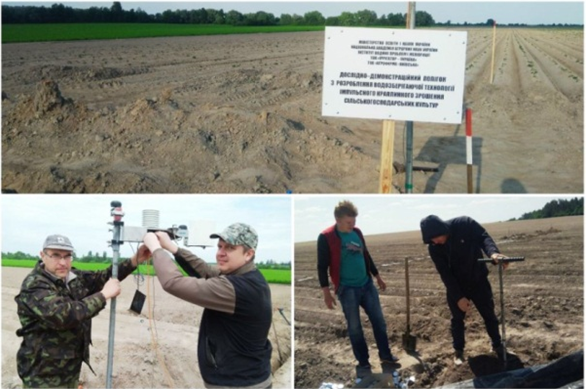
The Institute participated in workshops organized by the European Institute of Innovation and Technology (EIT) Climate-KIC to develop a "Roadmap for Climate-Smart Post-War Recovery in Ukraine." These workshops took place online on February 16th and March 23rd.
Capacity building. The Institute's staff members participated in the following professional development activities: (1) Lecture on modern requirements for preparing scientific papers (Kyiv, April 5); (2) webinars on improving soil management (March 9) and professional development (July 19).
During a visit to the "Water Laboratory" of the Water Supply and Sanitation Department of the Kyiv National University of Construction and Architecture , postgraduate students of the Institute learned operation of the experimental plant that selects types and doses of coagulants for drinking water treatment. An agreement was reached on joint research on water supply (Kyiv, October 13).
The Institute's scientists conducted a workshop for students at the National University of Life and Environmental Sciences of Ukraine. The workshop focused on micro-irrigation equipment testing procedures, compliance with international and national standards, and relevant normative documents and safety requirements (Kyiv, September 29).
Events. The IWPLR held online XI international scientific-practical conference "Accelerating changes to overcome the water crisis in Ukraine", the outcomes of which were presented in the Conference proceedings (Kyiv, March 22).
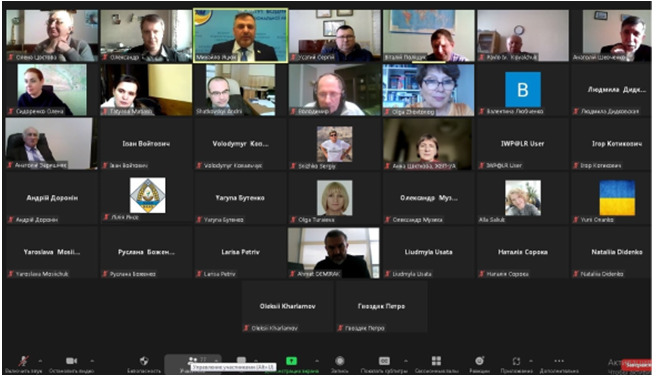
The Institute's management and scientific staff actively participated in various events: (1) scientific-practical conference: "Prospects of development of geoinformation technologies in the context of climate change" (Kyiv, April 20); (2) international conference "Impact of the Kakhovka Reservoir's Destruction on ecology and economy of the Northern Black Sea Region" (Kyiv, July 27); (3) Field Day (online, August 15); (4) World Water Week (online, August 24); (5) international seminar: "Subsoil and pulse drip irrigation for horticulture" (online, September 7); (6) All-Ukrainian Forum "Small rivers: climate and environmental challenges" (Zviahel, October 4-5); (7) meetings of the Presidium of the National Academy of Agrarian Sciences (Kyiv, September 13, October 25).
Cooperation. The Institute held a meeting with scientists from Wageningen University and the National University of Life and Environmental Sciences of Ukraine to identify promising areas for future collaboration and initiate the formation of scientific teams for joint project proposals.
In October, a delegation from Tajikistan, led by the Ambassador Extraordinary and Plenipotentiary of the Republic of Tajikistan to Ukraine, visited the Institute. The delegation was briefed on the Institute's key activities and achievements, and discussions were held on potential areas for future cooperation.
Publications. In 2023, the Institute published the monograph "Formation of irrigated bioenergetic agroecosystems in the forest steppe" edited by the acad. Yu. A. Tarariko. - Kyiv: Agrarna Nauka, 2023. - 128 p.

Media. The Director of the Institute was interviewed by TV channel "1+1" to discuss the environmental, water, and agricultural impacts of the Kakhovka HPP disaster and the consequences of the Kakhovka reservoir's drying up. Additionally, the Director was interviewed by the "Krym. Realii" radio channel on the issue of water shortages in Crimea.
Source: IWPLR of NAAS
10.3. International Research Institutes Working on Water Issues in Central Asia
Research Center for Ecology and Environment of Central Asia (RCEECA)
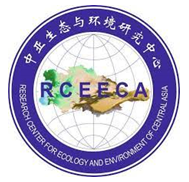 RCEECA was established in May 2013 by the Chinese Academy of Sciences in collaboration with the Kazakh, Kyrgyz and Tajik Academy of Sciences within the framework of "Developing Countries’ Science & Education Cooperation" Program.
RCEECA was established in May 2013 by the Chinese Academy of Sciences in collaboration with the Kazakh, Kyrgyz and Tajik Academy of Sciences within the framework of "Developing Countries’ Science & Education Cooperation" Program.
The Center's primary goal is to advance scientific research in ecology and environmental protection. This includes conducting fundamental and applied research in natural sciences and training highly qualified scientific personnel through graduate, postgraduate, doctoral, and targeted internship programs.
Currently, RCEECA operates through its Urumqi Headquarter and branches in Almaty, Bishkek, and Dushanbe. It also oversees 3 joint labs, 3 information centers, 15 field observation and research stations, and 4 experimental and demonstration sites for agricultural and environmental technologies across Kazakhstan, Kyrgyzstan, Tajikistan, and Uzbekistan.

Activities in 2023
Research. As part of the project "History and Current Development of Riparian Forests in Uzbekistan in the context of Global Hydroclimatic Changes and Human Impacts" , an expedition was conducted to assess the impact of hydrological and climatic changes on ecosystems in the Amu Darya, Syr Darya, and Zarafshan basins. The findings of this research will inform more sustainable water resource management, riparian forest conservation, and ecological restoration (Uzbekistan, April 22-May 1).
Recent activities included: (1) conducting UAV-based aerial surveys of the Maykhura River basin as part of the "Application of Unmanned Aerial Vehicles (UAV) for Monitoring the Typical Mountain Hazards in Tajikistan" project ; (2) collaborating with French geologists and paleontologists to study Eocene deposits in the Shibdara, Peshtova, Shuri-Bolo, and Argankul-Khibshon areas; (3) monitoring the state of glaciers and glacial lakes in the Surkhob River basin using UAV technology.
Capacity building. RCEECA jointly with the XIE&G of CAS and National Ecosystem Science Data Center held the "International Training Course on Terrestrial Ecological Monitoring Techniques and their Application in Central and West Asia" for experts from Kazakhstan, Kyrgyzstan, Tajikistan, Uzbekistan, Iran and Mongolia (Urumqi, PRC, September).
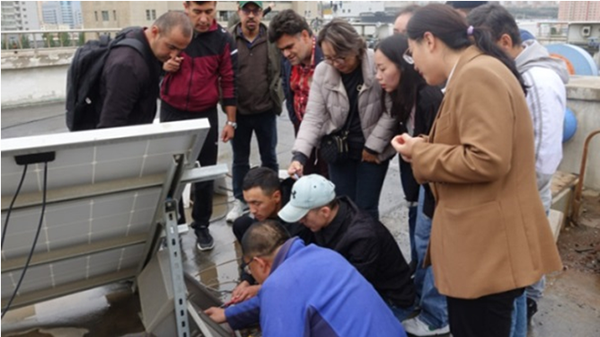
Events. Key events organized included: (1) International Symposium "One Belt, One Road" on sustainable development and natural disaster monitoring (Shenzhen, PRC, May 22); (2) I China-Iran Caspian Sea Ecosystem Symposium (Sari City, Mazandaran Province, Iran, July 8-9); (3) Issyk-Kul Forum "Actual issues of environmental research for sustainable development in arid zones" (Chok-Tal village, Issyk-Kul, August 16-17); (4) International Forum on Sustainable Development of Ecology and Environment in the Silk Road Economic Belt (Urumqi, September 18-19); (5) III International Symposium HiMAC 2023 (Urumqi, November 29 – December 1).
A kick-off meeting was held for the China-Tajikistan Intergovernmental Cooperation in International Science and Technology Innovation Project. Information was presented on four sub-projects: Assessment of degradation and sustainable utilization of grassland resources in Tajikistan; Study on water volume change and balance of Lake Sarez in Tajikistan; Dynamic monitoring and early prediction of agricultural drought and locust plague in Tajikistan; RS-based accurate monitoring and potential risk assessment on plateau-quake lake under sky-ground coordination (Dushanbe, Tajikistan, July 21).).

Source: RCEECA
